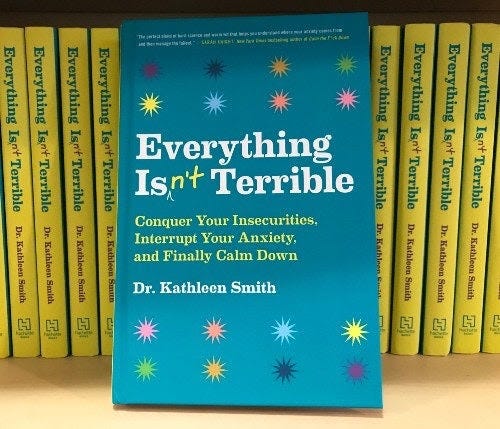The Trouble With Togetherness
De-blobbing yourself from your family's holiday patterns.
There are two things you need to know about families:
1. Families operate in predictable patterns to keep things calm.
2. Some families can respond more flexibly to stress than others.
Sprinkle some festive holiday anxiety on top, and family patterns become even more rigid. When I spent a week with my family at Thanksgiving, I saw these truths in action. Inevitably, I participated in them as well.
Exhibit A: I lost my phone a few times. As soon as people* sensed I was looking for something, they scrambled to action, peppering me with questions. I tried my best to keep my reactivity low. I said that I’d lost my phone, but didn’t need any help finding it. Can you guess what happened?
Before I could blink, my 90-year-old grandmother was diving under the sofa with a flashlight. She ignored my pleas for her to get off the floor and JUST. LET. ME. DO. IT.
In my family, a little bit of distress prompts a flurry of anxious fixing. In other families, people might bolt for the door or begin to criticize. A family with greater flexibility would be able to tolerate my mild frustration while I solved my own problem. Mine can at times, but the anxiety was dialed up this year for various reasons. We were functioning more as an anxiety-managing blob than as individual people. In Bowen theory, this is called togetherness.
A family with high togetherness:
Has trouble tolerating differences.
Finds people more irritating.
Has trouble tolerating people’s anxiety.
Has a high desire for closeness, but also a high allergicness to it.
Responds with predictable patterns to manage the anxiety.
Struggles to respond flexibly to challenges.
As an individual, I react to the togetherness by:
Avoiding telling people things that might upset them.
Reading a book or looking at my phone.
Lecturing others on how they need to change their behavior.
Just giving in and letting people do things for me.
These are all temporarily solutions. They can calm things down, but they don’t help me act as an individual and not just part of the blob.
Fortunately, I lost my phone enough times that I got to test out operating with just a teeny bit more maturity and flexibility. The third time, instead of trying to stop the blob, I just went about solving the problem. I activated the lost phone sound on my laptop while everyone scrambled. I reminded myself that my goal wasn’t to change the family. It wasn’t to teach people how to not annoy the hell out of me. My goal was to try my best not to add to the reactivity. To be in the family system, but to color outside the lines. To operate outside of the same, old patterns.
How do you encounter “togetherness” with your family over the holiday season? These are some of the challenges I’ve heard my clients thinking about:
How do I respond to tension between two other family members?
How do I broach an important subject when people just want to keep things light and fun?
What do I do if I see my spouse/kid not helping out or being social?
How do I juggle time between multiple families, knowing someone’s feelings will get hurt?
How do I be honest about what I’m comfortable with, regarding COVID safety?
If your goal is to get another person to do X, or not feel Y, then good luck. If your goal is to be an individual amidst the togetherness, you might get somewhere. If you show up, you can certainly rely on your family to give you opportunities to practice.
For better or worse, family patterns have helped us all chug along in challenging times. Seeing these behaviors as neither bad nor good, just the evolutionary heritage of humans, can help you shift away from blame and frustration. It helps you set your sights on the only variable you can tinker with—yourself.
My hope for myself this holiday season is that I don’t get distracted and try to change how families operate. That I can play around with new ways to relate to people, ways that don’t involve avoiding, controlling, or giving in.
What does it mean to be a member of one’s family, but also a representative of oneself? To activate your best thinking when the system has other ideas about how to keep things calm? It’s enough to keep one busy for a lifetime.
*Special shout-out to my husband, who never tries to find my phone. He is a gift.
News from Kathleen
I talked with Morra Aarons-Mele on the Harvard Business Review’s Anxious Achiever podcast about how family dynamics play out at work.
For Medium’s Forge Mag, I wrote about why we always assume we’re annoying everyone. I also wrote about the different ways we use our relationships to manage anxiety.
Want to support my free newsletter? Buy me a coffee to keep the thoughts flowing.
Want to read more of my writing? You can read old newsletters at my website, or buy my book Everything Isn't Terrible from Amazon, Barnes and Noble, Indiebound, or your local bookstore (best option).
Want a free anxiety journal? Calming Down & Growing Up: A 30 Day Anxiety Journal includes thirty daily prompts to help you reflect on and respond to your anxious behaviors. To receive a copy, just email me your receipt of Everything Isn’t Terrible.
Follow me on Twitter, Facebook, or Instagram, or email me if you have questions about Bowen theory coaching or having me speak to your group.
Want to learn more about Bowen theory? Visit the Bowen Center’s website to learn more about their conferences and training programs.




I have your book and it's been a good, easy-to-read application of Bowen Theory. Thank you.